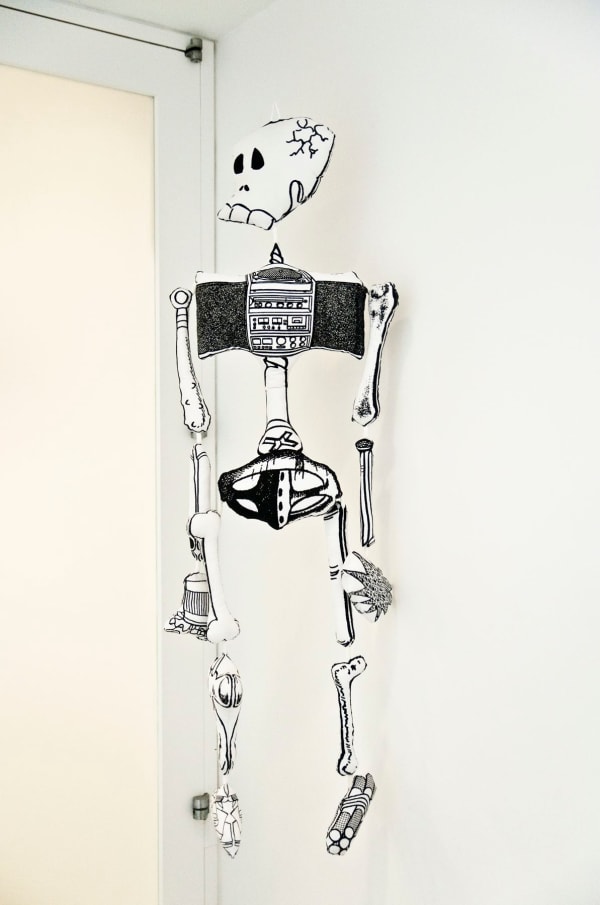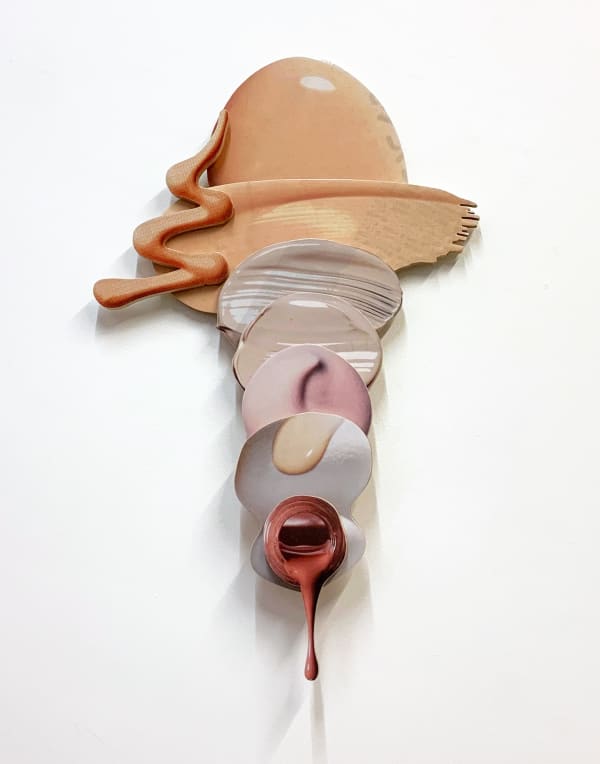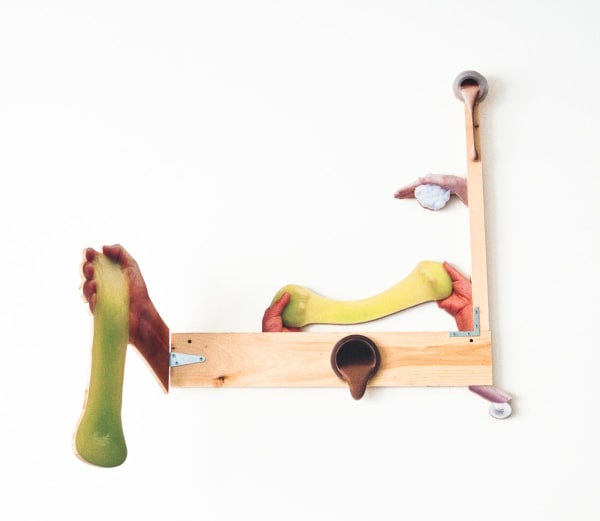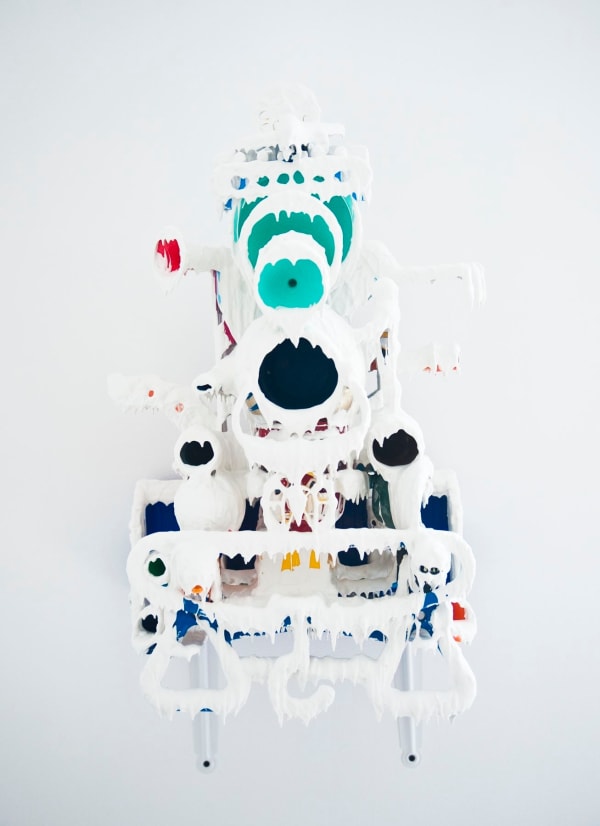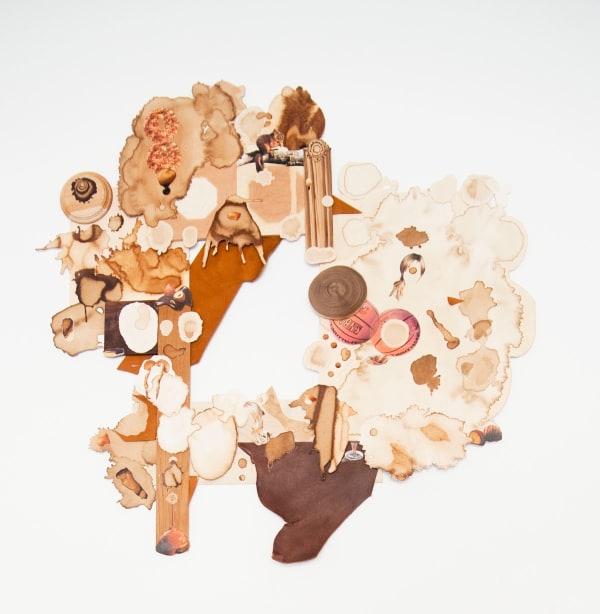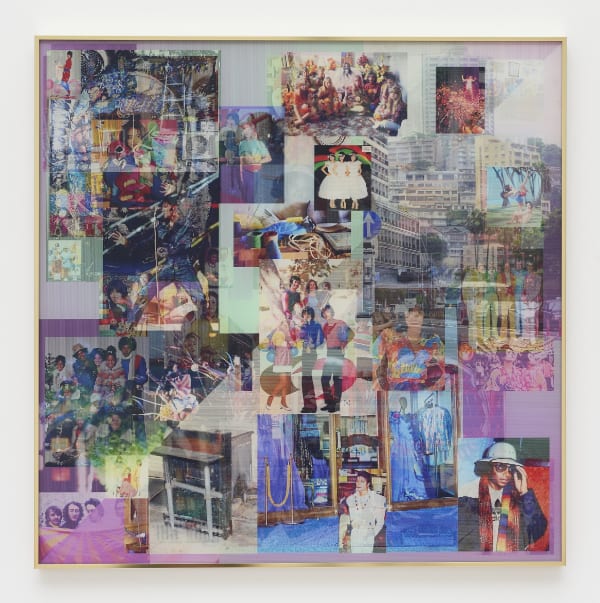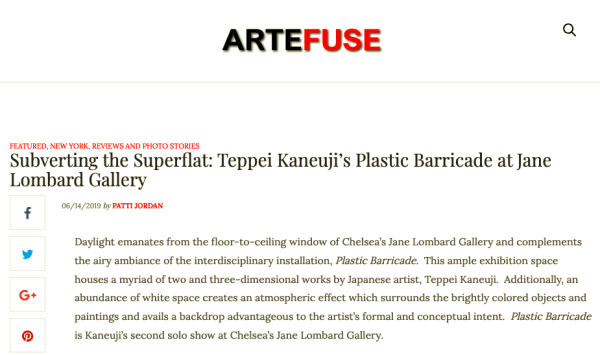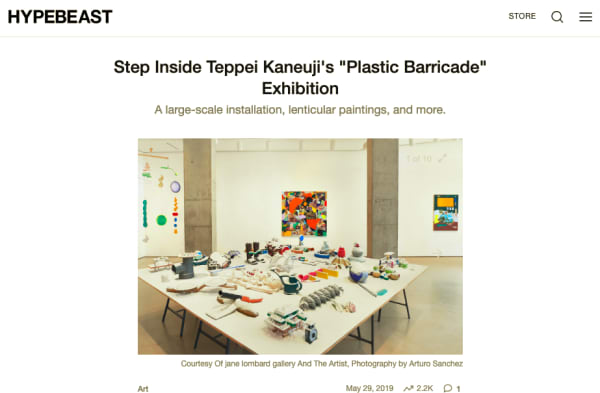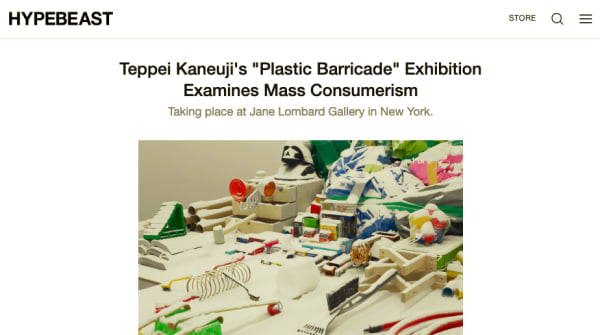Teppei Kaneuji
Teppei Kaneuji investigates the mass consumption of contemporary Japanese culture, sourcing materials from everyday life, found objects and manga characters to create sculpture that is at once playful and menacing. Kaneuji grafts together the detritus of overconsumption, creating candy-colored sculptures and prints with Manga-influenced lines that are the product of the overly stimulating, image-saturated culture in which he was raised. His signature series, White Discharge, (2002 onwards), consists of architectonic constructions assembling action figures, plastic food, and other small objects, covered with goopy white resin. Static yet dynamic in form, the unlikely allure of these bricolage entities lies in their embodiment of estranged elements; be they physical or psychological, attributes are layered, rationalized and given a new life through complex arrangements.
Teppei Kaneuji (b. 1978, Japan) lives and works in Kyoto, Japan. Kaneuji earned an MFA in sculpture at Kyoto City University of the Arts in 2003. His work has been exhibited at Ichihara Lakeside Museum, Chiba, Japan; The Japan Society, New York, NY; Ueno Royal Museum, Tokyo, Japan; Marugame Geniciro-Inokuma Museum of Contemporary Art, Kagawa, Japan; Kyoto Art Center, Kyoto, Japan; Singapore Tyler Print Institute, Singapore; Ullens Center for Contemporary Art, Beijing, China; Hyogo Prefectural Museum of Art, Kobe, Japan; Yokohama Museum of Art, Kanagawa, Japan; Hiroshima City Museum of Contemporary Art, Hiroshima, Japan; Museum of Contemporary Art, Tokyo, Japan; Ludwig Museum of Contemporary Art, Budapest, Hungary; Mori Art Museum, Tokyo, Japan; National Museum of Art, Osaka, Japan; and The Museum of Art, Seoul National University, Seoul, Korea, among many others. Kaneuji was awarded the Sovereign Asian Art Prize, Hong Kong (2016); Best Young Artist Award, City of Kyoto, Japan; and the Sakuya-Konohana Award. Works by Kaneuji are included in the public collections of several Japanese institutions, such as the Yokohama Museum of Art, Yokohama; Mori Art Museum, Tokyo; Hiroshima City Museum of Contemporary Art, Hiroshima; Takamatsu City Museum of Art, Kagawa; Museum of Contemporary Art Tokyo; The National Museum of Art, Osaka; Toyota Municipal Museum of Art, Toyota; 21st Century Museum of Contemporary Art, Kanazawa; as well as several international collections, such as the Queensland Art Gallery, Queensland and the Gallery of Modern Art, Brisbane, in Australia; the Ullens Foundation Collection, Beijing, China; and KADIST, Paris, France.
-
 Sea and Pus (Photograph of Cat) #12, 2022
Sea and Pus (Photograph of Cat) #12, 2022 -
 Sea and Pus (Photograph of Cat) #3 , 2022
Sea and Pus (Photograph of Cat) #3 , 2022 -
 Sea and Pus (Photograph of Cat) #8 , 2022
Sea and Pus (Photograph of Cat) #8 , 2022 -
 ZONES (Airport) #1, 2019
ZONES (Airport) #1, 2019 -
 ZONES (Block) #1, 2019
ZONES (Block) #1, 2019 -
 ZONES (House) #1, 2019
ZONES (House) #1, 2019 -
 ZONES (House) #2, 2019
ZONES (House) #2, 2019 -
 ZONES (House) #3, 2019
ZONES (House) #3, 2019 -
 ZONES (Mountain) #1, 2019
ZONES (Mountain) #1, 2019 -
 Games, Dance, and the Constructions (soft toy/skeleton), 2015
Games, Dance, and the Constructions (soft toy/skeleton), 2015 -
 Games, Dance, and the Constructions (soft toys) #18, 2015
Games, Dance, and the Constructions (soft toys) #18, 2015 -
 Games, Dance, and the Constructions (soft toys) #19, 2015
Games, Dance, and the Constructions (soft toys) #19, 2015 -
 Games, Dance, and the Constructions (soft toys) #21, 2015
Games, Dance, and the Constructions (soft toys) #21, 2015 -
 Games, Dance, and the Constructions (soft toys) #22, 2015
Games, Dance, and the Constructions (soft toys) #22, 2015 -
 Games, Dance, and the Constructions (soft toys) #23, 2015
Games, Dance, and the Constructions (soft toys) #23, 2015 -
 Games, Dance, and the Constructions (unfinished plywood) #1, 2015
Games, Dance, and the Constructions (unfinished plywood) #1, 2015 -
 Games, Dance, and the Constructions (unfinished plywood) #3, 2015
Games, Dance, and the Constructions (unfinished plywood) #3, 2015 -
 Games, Dance, and the Constructions (unfinished plywood) #4, 2015
Games, Dance, and the Constructions (unfinished plywood) #4, 2015 -
 Games, Dance, and the Constructions (unfinished plywood) #6, 2015
Games, Dance, and the Constructions (unfinished plywood) #6, 2015 -
 Ghost in the Liquid Room (foundation) #2, 2015
Ghost in the Liquid Room (foundation) #2, 2015 -
 Ghost in the Liquid Room (nail polish and body cream) #1, 2015
Ghost in the Liquid Room (nail polish and body cream) #1, 2015 -
 Ghost in the Liquid Room (nail polish and body cream) #2, 2015
Ghost in the Liquid Room (nail polish and body cream) #2, 2015 -
 Ghost in the Liquid Room (nail polish and body cream) #6, 2015
Ghost in the Liquid Room (nail polish and body cream) #6, 2015 -
 Ghost in the Liquid Room (slime and foundation), 2015
Ghost in the Liquid Room (slime and foundation), 2015 -
 Muddy Stream from a Mug (Hamburger #2), 2015
Muddy Stream from a Mug (Hamburger #2), 2015 -
 Muddy Stream from a Mug (Sandwich), 2015
Muddy Stream from a Mug (Sandwich), 2015 -
 Teenage Fan Club #67, 2015
Teenage Fan Club #67, 2015 -
 White Discharge (Built-up Objects) #41, 2015
White Discharge (Built-up Objects) #41, 2015 -
 White Discharge (White Pipes), 2015
White Discharge (White Pipes), 2015 -
 Ghost in the Liquid Room (metal #2), 2014
Ghost in the Liquid Room (metal #2), 2014 -
 Muddy Stream from a Mug, 2014
Muddy Stream from a Mug, 2014 -
 White Discharge (Built-up Objects #36), 2014
White Discharge (Built-up Objects #36), 2014 -
 White Discharge (Built-up Objects #37), 2014
White Discharge (Built-up Objects #37), 2014 -
 Muddy Stream from a Mug, 2009
Muddy Stream from a Mug, 2009
-

Double Trouble: CMTK (Chihiro Mori x Teppei Kaneuji)
January 13 - March 3, 2023Jane Lombard Gallery is pleased to present Double Trouble , a two-person project by Kyoto-based artists Teppei Kaneuji and Chihiro Mori. Collaborating under the name “CMTK,” the duo’s new and...Read more -

Drawn Together
A group exhibition of works on paper November 12 - December 18, 2021Jane Lombard Gallery is pleased to present Drawn Together , a group exhibition of works on paper. Featuring artworks by Jane Bustin, Squeak Carnwath, Sarah Dwyer, Richard Ibghy & Marilou...Read more -

Teppei Kaneuji: Plastic Barricade
May 23 - July 3, 2019Jane Lombard Gallery is pleased to present, Plastic Barricade , an exhibition featuring new work by Kyoto-based artist, Teppei Kaneuji. Kaneuji investigates natural phenomena, history and mass consumption and his...Read more -

Teppei Kaneuji: Deep Fried Ghost
September 10 - October 17, 2015Read more
-
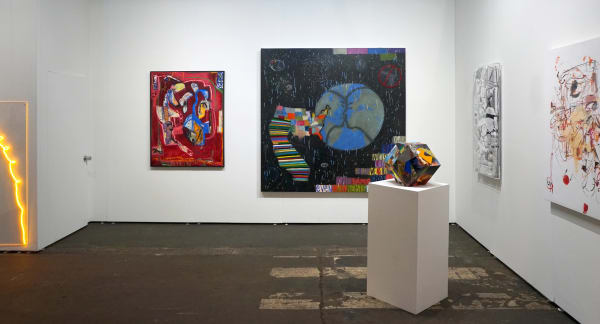
Untitled San Francisco 2020
January 16 - 19, 2020Jane Lombard Gallery is excited to present works by Squeak Carnwath, James Clar, Sarah Dwyer, Teppei Kaneuji, Carmen Neely, and Elizabeth Schwaiger for UNTITLED, San...Read more -

Seattle Art Fair 2016
August 4 - 7, 2016For the 2016 edition of Seattle Art Fair Jane Lombard Gallery is pleased to present works by Squeak Carnwath, James Clar, Sarah Dwyer, Teppei Kaneuji,...Read more
-

MOT Collection: Membrane of the Time
Teppei Kaneuji at Museum of Contemporary Art TokyoMuseum of Contemporary Art Tokyo, July 15, 2023 -

Collection Highlights
Teppei Kaneuji at Hiroshima MoCAHiroshima MoCA, July 1, 2023 -

The Cuteness Factor
Teppei Kaneuji at the Ludwig Museum, Cologne, GermanyLudwig Museum, June 24, 2023 -

EXHIBITION REVIEW: CMTK | DOUBLE TROUBLE
Luxi He, Musée, February 8, 2023 -

Eraser Mountain
Teppei Kaneuji and Toshiki Okada at NYU SKIRBALLNYU SKIRBALL, April 27, 2020 -

Environmental Theater Premiere From Japan's Toshiki Okada: ERASER MOUNTAIN At NYU Skirball
A.A. Cristi, Broadway World, January 16, 2020 -

Subverting the Superflat: Teppei Kaneuji’s Plastic Barricade at Jane Lombard Gallery
Patti Jordan, Artfuse, June 14, 2019 -

Step Inside Teppei Kaneuji's "Plastic Barricade" Exhibition
Keith Estiler, Hypebeast, May 29, 2019 -

Art On Display! Teppei Kaneuji’s “Plastic Barricade” Exhibition
Shane Breen, StupidDope, May 23, 2019 -

Teppei Kaneuji's "Plastic Barricade" Exhibition Examines Mass Consumerism
Charlie Zhang, Hypebeast, May 22, 2019










